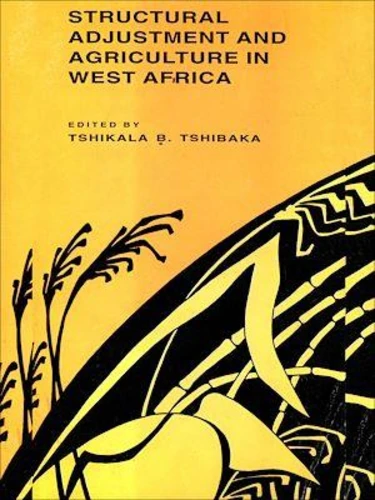Structural adjustment and agriculture in west Africa
Par :Formats :
Disponible dans votre compte client Decitre ou Furet du Nord dès validation de votre commande. Le format ePub est :
- Compatible avec une lecture sur My Vivlio (smartphone, tablette, ordinateur)
- Compatible avec une lecture sur liseuses Vivlio
- Pour les liseuses autres que Vivlio, vous devez utiliser le logiciel Adobe Digital Edition. Non compatible avec la lecture sur les liseuses Kindle, Remarkable et Sony
 , qui est-ce ?
, qui est-ce ?Notre partenaire de plateforme de lecture numérique où vous retrouverez l'ensemble de vos ebooks gratuitement
Pour en savoir plus sur nos ebooks, consultez notre aide en ligne ici
- Nombre de pages398
- FormatePub
- ISBN978-2-86978-966-1
- EAN9782869789661
- Date de parution01/01/2020
- Protection num.Digital Watermarking
- Taille2 Mo
- Infos supplémentairesepub
- ÉditeurCODESRIA
Résumé
Since the emergence of post-independence Africa, no socioeconomic and political policy has had such dramatic impact on the lives of Africans as the structural adjustment programme has done. And given its significance to and influence on every aspect o f the economies of sub-Saharan Africa, agriculture has borne the brunt o f the most far-reaching micro- and macroeconomic changes introduced during the adjustment era.
After more than a decade of its implementation, there should be enough data to justify and assess the real winners and losers o f the structural adjustment policy. Has the placebo resuscitated the dying economies in the subregion? Or due to its sudden and forceful implementation strategy, has the SAP reform left in its wake distressed and destabilised economies and social networks? More than ever before, Structural Adjustm ent and Agriculture in West A frica investigates the veracity of the successes and failures of the SAP.
This book, containing six thoroughly researched analyses o f different sectors in the economy as they affect agriculture in three countries : Ghana, Nigeria and Senegal, encompasses, but most important, also goes beyond the « pricist » paradigm to interpret the potential of the SAP as an instrument of economic rejuvenation. The researchers tried to identify gaps in the perspectives currently being employed in SAP analyses, seeking explanations to the structural boosters and constraints which determine growth in agriculture and in the subregion.
The book is an invaluable contribution to economic policy- analysis and making in Africa.
After more than a decade of its implementation, there should be enough data to justify and assess the real winners and losers o f the structural adjustment policy. Has the placebo resuscitated the dying economies in the subregion? Or due to its sudden and forceful implementation strategy, has the SAP reform left in its wake distressed and destabilised economies and social networks? More than ever before, Structural Adjustm ent and Agriculture in West A frica investigates the veracity of the successes and failures of the SAP.
This book, containing six thoroughly researched analyses o f different sectors in the economy as they affect agriculture in three countries : Ghana, Nigeria and Senegal, encompasses, but most important, also goes beyond the « pricist » paradigm to interpret the potential of the SAP as an instrument of economic rejuvenation. The researchers tried to identify gaps in the perspectives currently being employed in SAP analyses, seeking explanations to the structural boosters and constraints which determine growth in agriculture and in the subregion.
The book is an invaluable contribution to economic policy- analysis and making in Africa.
Since the emergence of post-independence Africa, no socioeconomic and political policy has had such dramatic impact on the lives of Africans as the structural adjustment programme has done. And given its significance to and influence on every aspect o f the economies of sub-Saharan Africa, agriculture has borne the brunt o f the most far-reaching micro- and macroeconomic changes introduced during the adjustment era.
After more than a decade of its implementation, there should be enough data to justify and assess the real winners and losers o f the structural adjustment policy. Has the placebo resuscitated the dying economies in the subregion? Or due to its sudden and forceful implementation strategy, has the SAP reform left in its wake distressed and destabilised economies and social networks? More than ever before, Structural Adjustm ent and Agriculture in West A frica investigates the veracity of the successes and failures of the SAP.
This book, containing six thoroughly researched analyses o f different sectors in the economy as they affect agriculture in three countries : Ghana, Nigeria and Senegal, encompasses, but most important, also goes beyond the « pricist » paradigm to interpret the potential of the SAP as an instrument of economic rejuvenation. The researchers tried to identify gaps in the perspectives currently being employed in SAP analyses, seeking explanations to the structural boosters and constraints which determine growth in agriculture and in the subregion.
The book is an invaluable contribution to economic policy- analysis and making in Africa.
After more than a decade of its implementation, there should be enough data to justify and assess the real winners and losers o f the structural adjustment policy. Has the placebo resuscitated the dying economies in the subregion? Or due to its sudden and forceful implementation strategy, has the SAP reform left in its wake distressed and destabilised economies and social networks? More than ever before, Structural Adjustm ent and Agriculture in West A frica investigates the veracity of the successes and failures of the SAP.
This book, containing six thoroughly researched analyses o f different sectors in the economy as they affect agriculture in three countries : Ghana, Nigeria and Senegal, encompasses, but most important, also goes beyond the « pricist » paradigm to interpret the potential of the SAP as an instrument of economic rejuvenation. The researchers tried to identify gaps in the perspectives currently being employed in SAP analyses, seeking explanations to the structural boosters and constraints which determine growth in agriculture and in the subregion.
The book is an invaluable contribution to economic policy- analysis and making in Africa.



